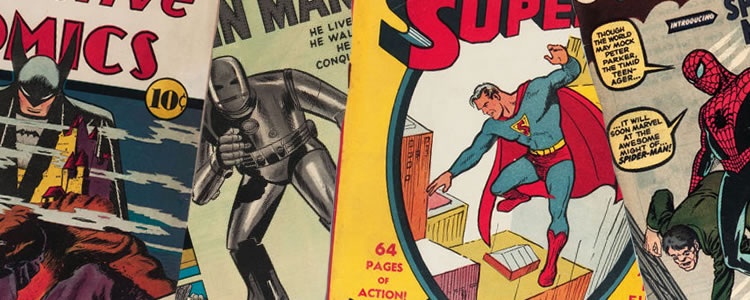
How much is an old comic book worth? A few bucks? Hundreds? Thousands?
Millions?
The answer is “yes” to all of the above – and “no.” While it’s true that a handful of really rare comics have sold for astronomical prices in the past few years (including a copy of Detective Comics #27, featuring Batman’s first appearance, that Heritage sold in 2010 for a whopping $1,075,500), the majority of the old comic books still in existence are worth relatively little.
Still, there are those that command big prices, and the news of those mind-blowing transactions has traveled the world. People are now actively hunting them down, “American Pickers” style, going to garage and yard sales, flea markets, thrift stores, etc., in the hoped that they might find the next “Holy Grail” comic book.
Now might be a good time to go over a few basics when searching these elusive treasures out.
First, ignore most “modern” comic books. While there is the occasional newer comic that captures the public’s fascination enough to cause prices to soar (case in point: the first issue of The Walking Dead, made super-popular by the runaway hit TV series), most remain easy to find for modest prices.
Why is this?
Let’s consider a few important facts.
First, since the dawn of the American comic book in 1933, the traditional thought was that comic books were disposable entertainment for children, and very, very few people took them seriously enough to save them in pristine condition. Oh, lots of people saved them, but the majority of these were heavily read and reread, and then stashed away in a truck in the attic.
It was the 1966 Batman TV series that really awoke the general public to the joys of comic collecting, and what had been a looked-down-upon hobby enjoyed by a few “nerds” blossomed into an industry that supports huge conventions all around the world, and inspired dozens of hit movies and television series.
By the late sixties, even though the general public’s perception of comics as “trash” continued, their popularity grew by leaps and bounds. In the 1970s, specialty stores selling nothing but comic books and related material popped up and the entire game changed.
Before then, comic books were sold in newsstands, drug stores, candy stores and the like; these vendors would stock 2-5 copies of each title, and that was it – when they sold out, they were gone (and if they didn’t sell, the news dealers ripped the title off the cover and sent it in for credit).
Now, with comic shops taking over the business, many more copies of each new issue were stocked, and this time when they didn’t sell out, they immediately became “back issue stock.”
In other words, there was no shortage of the newer books. Add to that the collectors who noticed the prices of older issues going up, who began buying extra copies to be set back and resold (for a big profit, of course) at some later date.
Get the picture?
Whereas once, back issue comics were difficult to locate, they were now readily available through stores and “fanzines” like Rockets Blast Comic Collector and The Buyer’s Guide for Comic Fandom, where “comic book dealers” ran ads selling these old treasures from years gone by.
When eBay came along, even more hidden-away collections surfaced and were sold online.
Still, finding superhero and “action/adventure” comics with original cover prices of 12 to 25 cents in exceptional condition can be valuable, even copies printed after 1966 – like in most collectibles, the condition is always important; with comics, the lack of visible handling wear on the covers is far more important than how clean and “readable” the inside pages might be.
Like other “hot ticket” collectibles, old comic books stay valuable because there are people out there who actively search them out. That doesn’t always mean all old comic books are highly desirable.
Take for instance the once popular “Cowboy” comics from the 1940s and ‘50s, starring well-known movie and television stars like Gene Autry, Roy Rogers, Johnny Mack Brown, and others. Collectors loved these back in the 1970s and ‘80s, but around the 1990s, demand started to drop off.
The types of collectors interested in these books appear to have slowed down their buying habits as they age, and few newer fans have picked up the slack.
But superheroes still reign supreme with collectors young and old alike, so our advice to you flea market and yard sale pickers is to keep looking for Batman, Superman, Spider-Man, Captain America, and the like, and pay close attention to those original cover prices – the lower, the better.
There are still many treasures left out there – for those who know how to look! And if you have questions about what you find, that’s where we can help, so don’t be shy about dropping us a line!
We’d love to make you the next Comic Book Millionaire!
Click HERE for Heritage’s FREE comic value guide.
By David Tosh


Leave a Comment